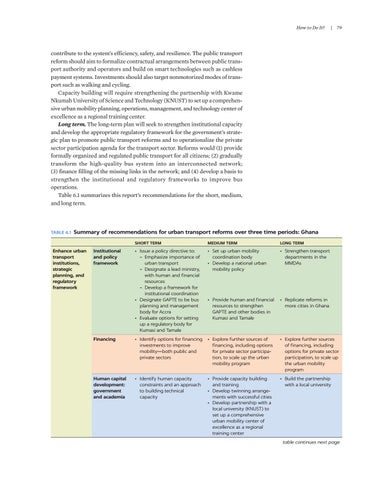How to Do It? | 79
contribute to the system’s efficiency, safety, and resilience. The public transport reform should aim to formalize contractual arrangements between public transport authority and operators and build on smart technologies such as cashless payment systems. Investments should also target nonmotorized modes of transport such as walking and cycling. Capacity building will require strengthening the partnership with Kwame Nkumah University of Science and Technology (KNUST) to set up a comprehensive urban mobility planning, operations, management, and technology center of excellence as a regional training center. Long term. The long-term plan will seek to strengthen institutional capacity and develop the appropriate regulatory framework for the government’s strategic plan to promote public transport reforms and to operationalize the private sector participation agenda for the transport sector. Reforms would (1) provide formally organized and regulated public transport for all citizens; (2) gradually transform the high-quality bus system into an interconnected network; (3) finance filling of the missing links in the network; and (4) develop a basis to strengthen the institutional and regulatory frameworks to improve bus operations. Table 6.1 summarizes this report’s recommendations for the short, medium, and long term.
TABLE 6.1 Summary
Enhance urban transport institutions, strategic planning, and regulatory framework
of recommendations for urban transport reforms over three time periods: Ghana SHORT TERM
MEDIUM TERM
LONG TERM
• Issue a policy directive to: –– Emphasize importance of urban transport –– Designate a lead ministry, with human and financial resources –– Develop a framework for institutional coordination • Designate GAPTE to be bus planning and management body for Accra • Evaluate options for setting up a regulatory body for Kumasi and Tamale
• Set up urban mobility coordination body • Develop a national urban mobility policy
• Strengthen transport departments in the MMDAs
• Provide human and financial resources to strengthen GAPTE and other bodies in Kumasi and Tamale
• Replicate reforms in more cities in Ghana
Financing
• Identify options for financing investments to improve mobility—both public and private sectors
• Explore further sources of financing, including options for private sector participation, to scale up the urban mobility program
• Explore further sources of financing, including options for private sector participation, to scale up the urban mobility program
Human capital development: government and academia
• Identify human capacity constraints and an approach to building technical capacity
• Provide capacity building and training • Develop twinning arrangements with successful cities • Develop partnership with a local university (KNUST) to set up a comprehensive urban mobility center of excellence as a regional training center
• Build the partnership with a local university
Institutional and policy framework
table continues next page



